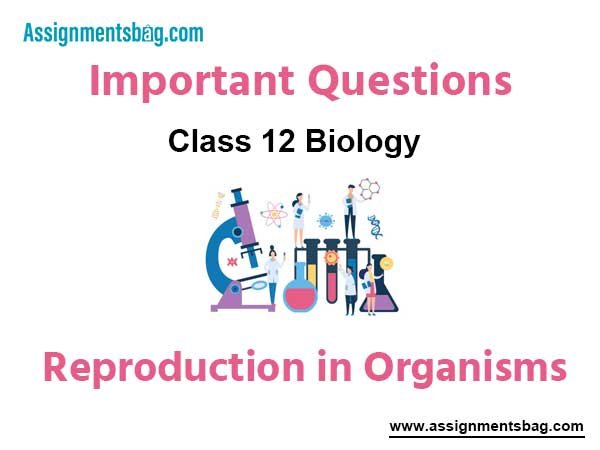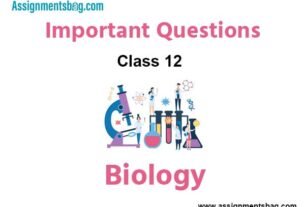Please refer to Reproduction In Organisms Class 12 Biology Important Questions with solutions provided below. These questions and answers have been provided for Class 12 Biology based on the latest syllabus and examination guidelines issued by CBSE, NCERT, and KVS. Students should learn these problem solutions as it will help them to gain more marks in examinations. We have provided Important Questions for Class 12 Biology for all chapters in your book. These Board exam questions have been designed by expert teachers of Standard 12.
Class 12 Biology Important Questions Reproduction In Organisms
Very Short Answer Questions
Question. State the fate of a pair of autosomes during gamete formation.
Ans. During gamete formation a pair of autosomes segregate from each other.
Question. Why is the offspring formed by asexual reproduction referred to as clone?
Ans. In asexual reproduction, the offspring are morphologically and genetically identical to the parent and to each other. Hence they are called clones.
Question. Mention the unique flowering phenomenon exhibited by Strobilanthus kunthiana (Neelakuranji).
Answer. Strobilanthus kunthiana flowers once in 12 years.
Question. Mention the site where syngamy occurs in amphibians and reptiles, respectively.
Answer. In amphibians, external fertilisation occurs hence, syngamy occurs in the medium of water. In reptiles, internal fertilisation occurs hence, syngamy occurs within the body of female parent.
Question. Name the group of organisms that produce non-motile gametes. How do they reach the female gamete for fertilisation?
Answer. Angiosperms produce non-motile gametes. They reach the female gamete with the help of air or water.
Question. Give reasons for the following:
Some organisms like honey-bees are called parthenogenetic animals.
Answer. Since drones/males develop from unfertilised eggs so they are called as parthenogenetic animals.
Short Answer Questions
Question. Name the units of vegetative propagation in water hyacinth. Explain giving reasons why it has become the most invasive aquatic weed.
Answer. Offsets are the unit of vegetative propagation in water hyacinth. Since the formation of hyacinth offsets does not involve two parents, the process involved is asexual, therefore they spread quickly.
Question. Name the vegetative propagules in the following: (a) Agave (b) Bryophyllum
Answer. (a) Agave—Bulbil (b) Bryophyllum—leaf buds/adventitous buds.
Question. How does the floral pattern of Mediterranean orchid Ophrys guarantee cross-pollination?
Answer. The orchid bears flowers which resemble the female wasp in colour, smell, as well as appearance.
The male pollinators mistake them as their female counterparts. Therefore, in the process of their pseudocopulation they pollinate the flower.
Question. Explain the significance of meiocytes in a diploid organism. [CBSE Delhi 2016]
Answer. In a diploid organism, meiocytes undergo meiosis to form haploid gametes. These help to restore diploidy (2n) through zygote formation or syngamy.
Question. Mention two important characteristics in the sexual reproduction of frogs and bony fishes.
Answer. Both these release the mature gametes simultaneously. They also release a large number of gametes in the water to enhance the chances of syngamy (external fertilisation).
Question. The number of taxa exhibiting asexual reproduction is drastically reduced in the higher plants (angiosperms) and higher animals (vertebrates) as compared with lower groups of plants and animals. Analyse the possible reasons for this situation.
Answer. Both angiosperms and vertebrates have a more complex structural organisation. They have evolved very efficient mechanism of sexual reproduction. Since asexual reproduction does not create new genetic pools in the offspring and consequently hampers their adaptability to external conditions, these groups have resorted to reproduction by the sexual method.
Question. Define external fertilisation. Mention its disadvantages.
Ans. The fusion of compatible gametes outside the body of the parent is called external fertilisation,e.g., in frog.
Disadvantages of external fertilisation:
(i) It requires a medium for fusion of gametes.
(ii) The young ones are often exposed to the predators and no parental care is provided.
Long Answer Questions
Question. Distinguish between asexual and sexual reproduction. Why is vegetative reproduction also considered as a type of asexual reproduction?
Answer. For differences, refer to Table 1.1.
Vegetative reproduction is considered as a type of asexual reproduction because
(i) it is uniparental reproduction,
(ii) there is no involvement of gametes or sex cells, and
(iii) cell division is mitotic and no reductional division takes place,
(iv) vegetative propagules are somatic cells.
(v) there is no variation among the progenies.
Question. Describe the post-fertilisation changes in a flower.
Answer. The post-fertilisation changes that take place in a flower are as follows:
(i) The formation of zygote (inside ovule) which later develops into an embryo and primary endosperm cell which in turn develops into endosperm (provides nourishment to the growing embryo).
(ii) While the sepals, petals and stamens are shed, the pistil remains intact.
(iii) The fertilised ovule develops into seeds.
(iv) The ovary matures into a fruit that later develops a thick, protective wall called pericarp.
(v) Seeds after dispersal, germinate under favourable conditions, which later develop into a new plant.
Question. Higher organisms have resorted to sexual reproduction in spite of its complexity. Why?
Answer. Higher organisms have resorted to sexual reproduction to
(i) get over the unfavourable condition,
(ii) introduce variation to enable better adaptive capacity, biological tolerance and competitive edge,
(iii) restore high gene pool in a population,
(iv) restore vigour and vitality of the race, and
(v) get proper parental care during vulnerable stage.
Question. Differentiate between a zoospore and a zygote.
Answer.
| S.No. | Zoospore | Zygote |
| (i) | These are endogenously, asexually produced,unicellular, naked and motile spores having one or two flagella | Zygote is a diploid cell formed by fusion of male and female gametes. |
| (ii) | It may be haploid or diploid. | It is always diploid. |
| (iii) | Zoospore takes part in dispersal. | Zygote does not have significant role in dispersal. |


